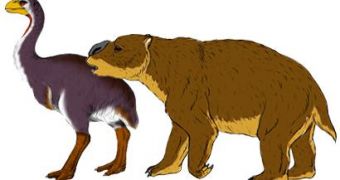Today the giants of the Australian fauna are the red kangaroos: males can grow up to 1.8m (6ft) tall and weigh up to 85 kg (187lbs). But they are just a pale copy of the beast that once roamed the continent.
Diprotodon, an Ice Age koala's relative, was as big as a hippopotamus! This was the largest marsupial ever.
Now Australian researchers say that they have come across the jawbone of a giant Diprotodon the size of a large car that lived 20,000-40,000 years ago. The over 30 cm (1 foot) long bone was discovered by a tour guide at the Jenolan Caves in the Blue Mountains west of Sydney.
Diprotodon was 2 m (6.5 feet) tall and 3 m (10 feet) long, weighing around 3 tonnes and was part of a pre-historic Australian "mega-fauna" that included giant cow-sized kangaroos and marsupial lions. Diprotodon's modern relatives are the wombats, which can be 1 m (3 ft) long, 25 cm (10 in) high and weigh 20-45 kg (44-100 pounds) and koala, which does not reach more than 14 kg (30 pounds).
"The discovery, the first so close to Sydney, could herald a major scientific site at the Jenolan Caves. If there's one jaw, there has to be more material and it could theoretically be on the edge of the beginning of a very large deposit and this is the first bit poking out of the wall and that there are some really fascinating mega-fauna fossils in this cave," said Michael Archers, paleontologist at the University of New South Wales.
"If indeed it is less than 40,000 years old as they say, then it is the youngest authenticated diprotodon jawbone because most people seem to think that diprotodon and the other giant animals of Australia became extinct earlier than this, about 45,000 years ago," said Dr Colin Groves from the Australian National University.
In this case the early Australians would have encountered the huge beast and this spurs the theory that the early Aborigines were involved in the rapid extinction of the Australian megafauna.
"If the date were really confirmed then this would refute, not the general idea that early people in Australia eliminated the giant fauna, but the idea that they did it very quickly, within say 5000 years of them arriving," said Groves.

 14 DAY TRIAL //
14 DAY TRIAL //